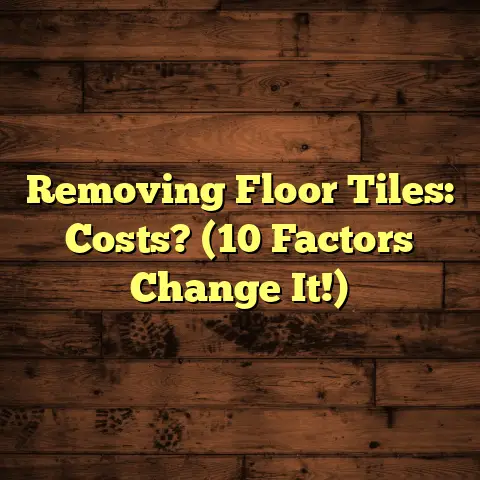Engineered Wood Cons? (7 Mistakes To Avoid!)
Ever seen those home makeover shows?
The before is always… well, before.
But the after?
Usually features stunning hardwood floors.
And more often than not, it’s engineered wood.
I remember a client, Sarah, who was over the moon.
She’d just finished building her dream home.
The centerpiece?
Beautiful, wide-plank engineered wood throughout.
Friends raved about it.
Family admired it.
She felt like she’d nailed the perfect blend of
style and practicality.
Then, the cracks started – both literally and figuratively.
Scratches appeared seemingly out of nowhere.
A leaky dishwasher led to some serious warping.
And the dream slowly started to fade.
Sarah’s not alone.
Engineered wood is fantastic, don’t get me wrong.
But it’s not a magic bullet.
There are definitely pitfalls to watch out for.
Let’s dive into the potential headaches and how to avoid them.
Section 1: Understanding Engineered Wood Flooring
What exactly is engineered wood flooring?
It’s not solid hardwood, that’s for sure.
Think of it as a multi-layered sandwich.
A core of plywood or high-density fiberboard (HDF).
Topped with a veneer of real hardwood.
This construction gives it a unique advantage.
It’s more stable than solid wood.
Less prone to expanding and contracting with humidity.
And that’s why it’s become so popular.
It offers the look of real wood.
But with added stability and often a lower price point.
Plus, installation can be easier.
Section 2: Mistake #1 – Ignoring Quality
Okay, here’s the first biggie: not all engineered wood is created equal.
I’ve seen some shockingly cheap stuff out there.
The veneer layer can be paper-thin.
The core materials can be flimsy.
Think of it like this: you get what you pay for.
A low-quality product is going to warp.
It’s going to chip.
And it’s going to have a much shorter lifespan.
Here’s a quick breakdown of quality factors:
Consequences: Choosing the cheap stuff?
You’re basically asking for trouble.
Warping is a huge issue.
Especially in areas with even slight moisture.
Chipping and denting become commonplace.
And you’ll be replacing it much sooner than you think.
My advice?
Don’t skimp on quality.
Do your research.
Look for a thicker veneer and a solid core.
It’ll save you money in the long run.
Section 3: Mistake #2 – Underestimating Moisture Sensitivity
Engineered wood is more moisture-resistant than solid wood.
But it’s not waterproof.
That’s a critical distinction.
I’ve seen countless cases where homeowners think.
“Oh, it’s engineered, I can put it anywhere!”
And then… disaster strikes.
Basements and bathrooms are notorious for moisture.
Even seemingly dry areas can have hidden leaks.
Or humidity issues that wreak havoc over time.
Consequences:
Install engineered wood in a high-moisture area without proper precautions?
You’re setting yourself up for: * Warping * Buckling * Mold growth
And trust me, mold remediation is not cheap. Not to mention the health risks.
What can you do?
- Moisture Barrier: Always use a proper moisture barrier.
- Ventilation: Ensure good ventilation in bathrooms and basements.
- Test: Test the subfloor for moisture content before installation.
- Pro Tip: Use a moisture meter, target <3% moisture.
- Avoid Problem Areas: Seriously reconsider using engineered wood in consistently damp areas.
Section 4: Mistake #3 – Overlooking the Importance of Installation
I cannot stress this enough: proper installation is key!
It doesn’t matter how high-quality your flooring is.
If it’s installed poorly, it’s going to fail.
DIY installations can be tempting.
Especially with all the tutorials online.
But flooring is trickier than it looks.
And hiring an inexperienced contractor can be just as bad.
Consequences:
Common installation mistakes include:
* Not acclimating the wood:
* Wood needs to adjust to the room’s humidity.
* Using the wrong underlayment:
* Underlayment provides cushioning and moisture protection.
* Leaving insufficient expansion gaps:
* Wood needs room to expand and contract.
* Improper subfloor preparation:
* Subfloor needs to be level and clean.
These mistakes can lead to: * Gaps between planks * Squeaky floors * Buckling
I once had to rip up an entire floor.
Because the installer didn’t leave enough expansion gap.
A costly mistake that could have been easily avoided.
My recommendation?
Hire a professional.
Check their credentials.
Read reviews.
And make sure they know what they’re doing.
Section 5: Mistake #4 – Neglecting Maintenance Needs
Engineered wood is relatively low-maintenance.
But it’s not maintenance-free.
You can’t just ignore it and expect it to look pristine forever.
Dirt, grit, and spills can all take their toll.
And the wrong cleaning products can damage the finish.
Consequences:
Neglecting maintenance can lead to: * Scratches * Dullness * A shortened lifespan
I’ve seen floors that looked ten years older than they were.
Simply because they weren’t properly cared for.
Here’s the lowdown on maintenance:
- Regular Cleaning: Sweep or vacuum regularly to remove dirt and debris.
- Proper Cleaning Products: Use cleaners specifically designed for engineered wood.
- Avoid Excess Water: Don’t soak the floor when mopping.
- Protective Measures: Use rugs in high-traffic areas and felt pads under furniture.
Pro Tip: Avoid steam mops. The heat and moisture can damage the finish.
Section 6: Mistake #5 – Misunderstanding Longevity and Repairability
Here’s a common misconception: “Engineered wood can be sanded and refinished like solid hardwood!”
Well, sometimes. But it’s not always that simple.
The ability to refinish engineered wood depends on:
* Veneer Thickness: A thicker veneer allows for more sanding.
* Number of Refinishes: Engineered wood can typically only be refinished once or twice, if at all.
Consequences:
Thinking you can refinish your engineered wood multiple times?
You might be in for a rude awakening.
If the veneer is too thin, sanding can expose the core.
And then you’re stuck with a damaged floor.
Even if you can refinish it, the process is more delicate.
And it might not look as good as a refinished solid hardwood floor.
My perspective?
Manage your expectations.
Engineered wood is durable.
But it won’t last forever.
And it’s not as easily repaired as solid wood.
Section 7: Mistake #6 – Disregarding Environmental Factors
Engineered wood is more stable than solid wood.
But it’s still affected by environmental conditions.
Humidity and temperature fluctuations can cause problems.
Excessive humidity can cause the wood to expand.
Dry conditions can cause it to contract.
And these changes can lead to:
- Gaps
- Buckling
- Cracking
Consequences:
Ignoring environmental factors can lead to: * Unstable flooring * Costly repairs
I’ve seen floors that looked perfectly fine in the summer.
Only to develop large gaps in the winter.
Due to the dry air from the heating system.
What can you do?
- Control Humidity: Maintain a consistent humidity level in your home.
- Proper Ventilation: Ensure good ventilation to prevent moisture buildup.
- Consider Climate: Choose engineered wood that’s appropriate for your climate.
Industry Insight: The ideal humidity level for wood flooring is between 30-50%.
Use a humidifier or dehumidifier to maintain this range.
Section 8: Mistake #7 – Failing to Factor in Resale Value
Finally, let’s talk about resale value.
Does engineered wood affect your home’s value compared to solid hardwood?
The answer is… it depends.
Buyer perceptions play a big role.
Some buyers prefer solid hardwood.
They see it as a more premium material.
Other buyers are more practical.
They appreciate the durability and lower cost of engineered wood.
Consequences:
Failing to consider resale value?
You might not get as much for your home.
As you would with solid hardwood floors.
According to a 2023 study by the National Association of Realtors.
Homes with hardwood floors tend to sell for slightly more.
Than homes with other types of flooring.
My take?
Don’t let resale value be the only factor.
Choose the flooring that best suits your lifestyle and budget.
But be aware of the potential impact on your home’s value.
Bottom Line:
Engineered wood can be a fantastic flooring option.
It offers the look of real wood with added stability and affordability.
But it’s not without its potential drawbacks.
Avoid these seven mistakes.
You’ll be well on your way to enjoying beautiful, long-lasting floors.
Remember Sarah, from the beginning?
Her story doesn’t have to be yours.
Do your homework.
Choose wisely.
And enjoy your gorgeous new floors!





